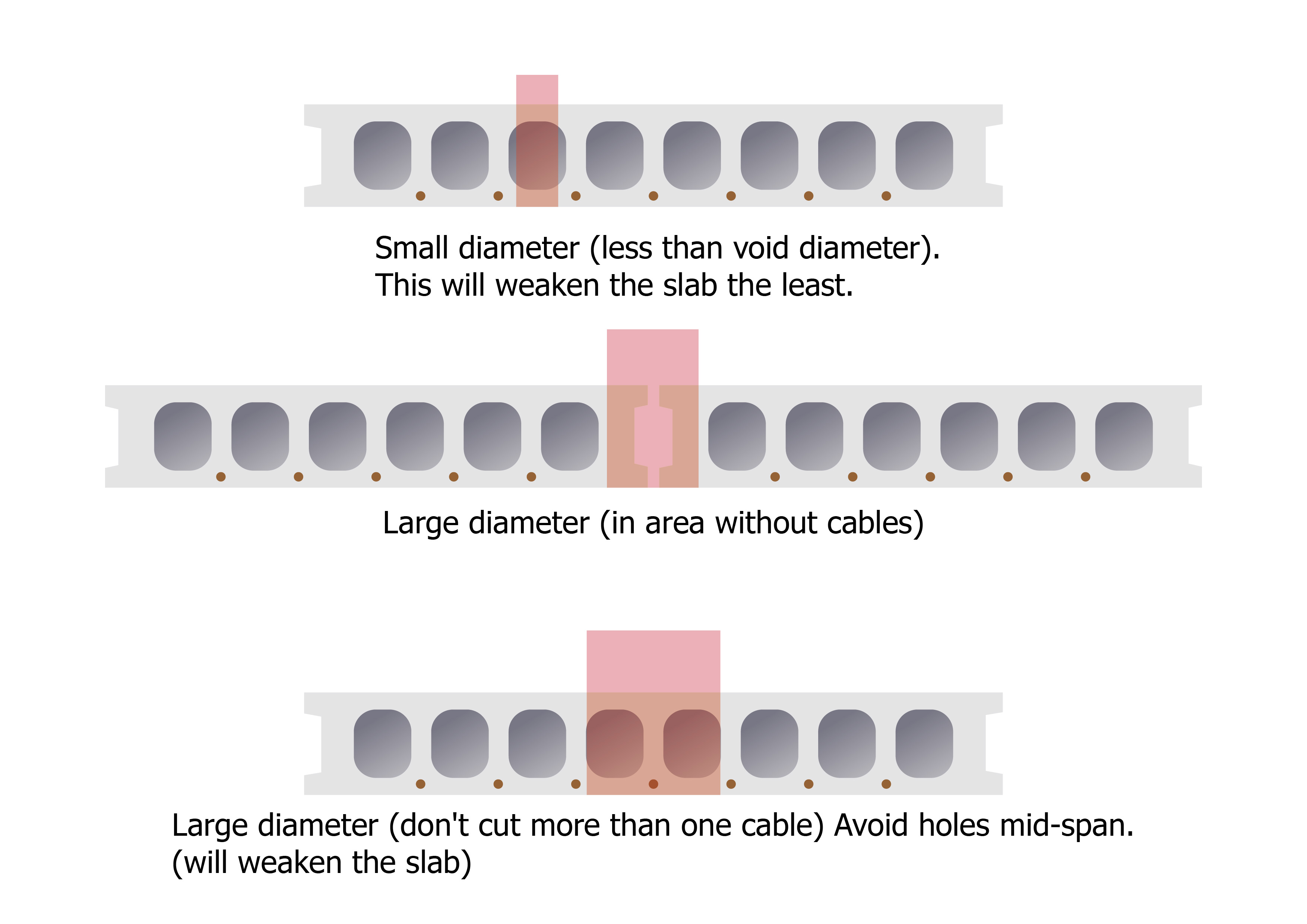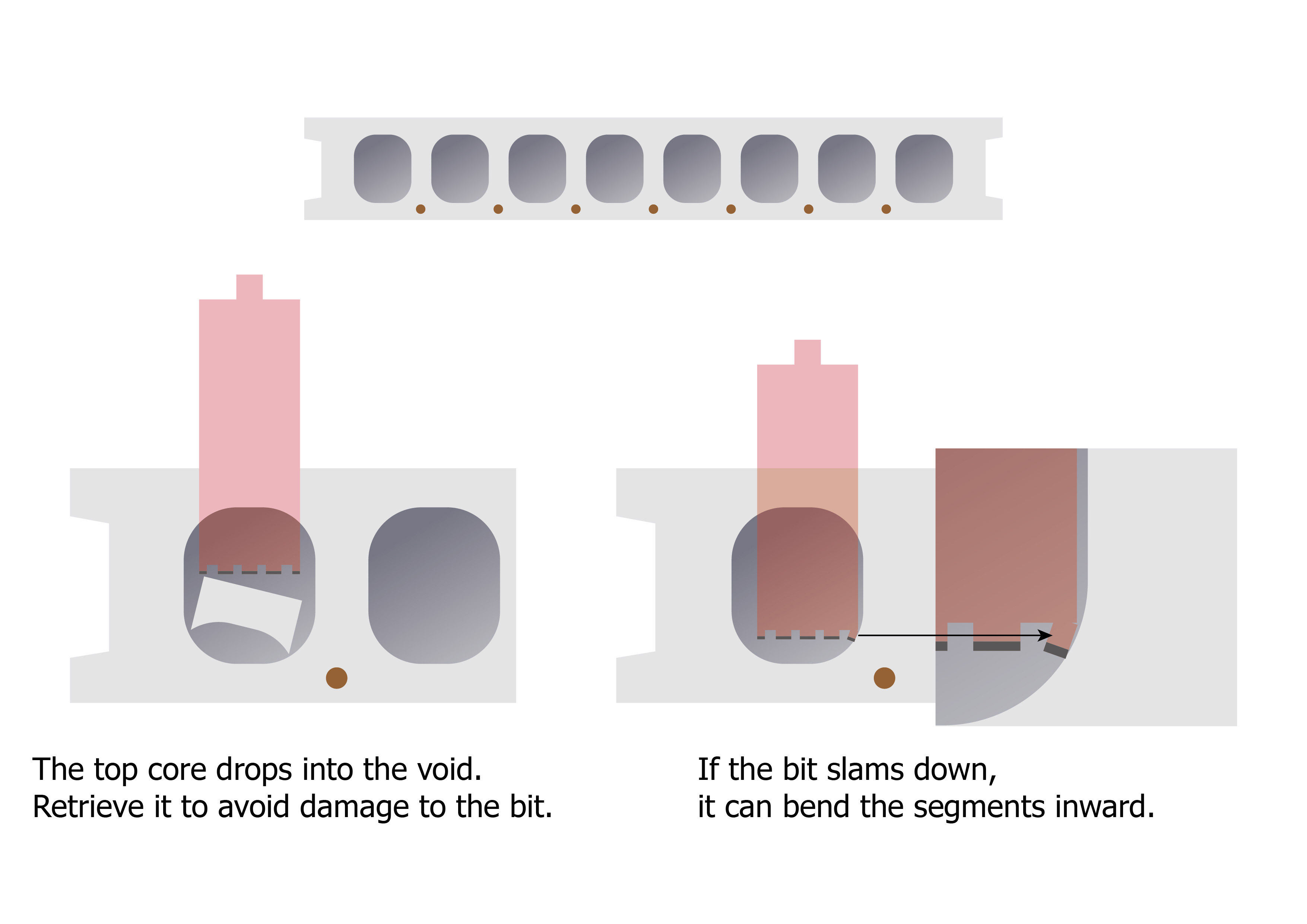October 7, 2025
What Are Hollow-Core Slabs?
These are pre-cast concrete planks used in construction, especially for floors.
They have lengthwise voids (cores) to save weight and are reinforced with prestressing cables to add strength.
The concrete used is especially hard. The slabs are delivered to the jobsite on trucks, so the slabs are long and narrow to fit on a truck.
The slabs are installed to the frame of the building with cranes.
The keyways between the slabs are then filled in and a thin layer of concrete is added to make a smooth surface.
Hollow-core slabs save a lot of time, weight, and cost over traditional methods.
Being made of especially hard concrete and with prestressing cables, they present unique challenges when they need to be drilled.
When Do They Need to Be Drilled?
Core drilling is often required for mechanical, electrical, and plumbing (MEP) contractors.
This includes HVAC (heating, ventilation and air-conditioning).
Most required openings will be small, and as long as no cables are cut, the impact on the strength of the slab will be minimal.
Key Points of Attention When Drilling.
• Avoid Cutting the Prestressing Cables
Locating and avoiding the prestressing cables are vitally important to ensure no structural damage will occur.
It is best to consult the slab supplier or to have the slab scanned with ground-penetrating radar (GPR) to know the exact location of the cables.
Accidentally striking hidden prestressed cables compromises structural safety.
• Center the Holes on the Void Areas
Optimally, drilling should be restricted to the areas of the voids, not compromising the webbing area or cables, so the diameter of the hole should be smaller than the void diameter.
• Multiple Openings
It’s best to avoid multiple openings in a single slab to prevent affecting the design capacity of the slab, but if the holes are along the same line of the slab and are not too close together, it will have less of a negative impact.
Multiple penetrations running transverse to the panel will lead to significant weakening of the panel.
• Large Openings
If it’s necessary to drill a hole larger than the diameter of the voids, try to find a section where there are no cables, such as at the lengthwise keyways between slabs.
If cutting a cable is absolutely unavoidable, use a bit made for drilling prestressed (with tight diamond segment spacing), don’t cut more than one cable, and locate the hole close to one of the ends of the slab.
Never cut a cable at the mid-span position!

What Problems Can Arise?
• Avoid Bit Damage
Since the operator is drilling into a hollow void in the slab, the resulting concrete core will have a top part and a lower part.
When the top half of the hole breaks through and the core drops into the void, there is a risk that this core could damage the core bit’s teeth.
The operator must stop and retrieve the top half core from the hole before proceeding to the bottom half.
In the second step, care must be taken to avoid the bit accidentally slamming down into the bottom of the void.
The curving sides of the bottom half of the void could bend the core bit’s segments inward.
Additionally, care must be taken to control the falling of the bottom half of the core when the second half of the hole breaks through.

• Uncontrolled Water Flow
Wet drilling will allow water and slurry to freely travel along the voids in the slab, leaking in unexpected places and making a huge mess.
To avoid this, dry drilling is the best method.

The Most Suitable Tool for the Job
• Best Choice: DD160 Diamond Core Drilling Motor
A coring motor designed for dry drilling of reinforced concrete with soft percussion is ideal.
For most drilling tasks in hollow-core slabs, the DD160 diamond core drilling motor is the best choice, since it was specifically designed for this application.
Its 2nd gear ratio is the optimal speed for the sizes of openings typically required, usually around Ø80 mm.
• Other Suitable Models
Others in the AGP range which are capable of dry drilling reinforced concrete will also work well.
The DM62 and DD62 diamond core drilling motors are heavier duty models which are also suitable.
For larger diameters, the DDC9 and DDC12 hybrid wet and dry coring motors (used in dry mode) would be the choice.
• Not Recommended Models
General-purpose dry drilling motors such as the DM52 should not be used because they are designed for drilling brick, not hard concrete.
Their gearing is too fast, and their impact mechanism is not designed for such a hard material.






.png)





.png)








